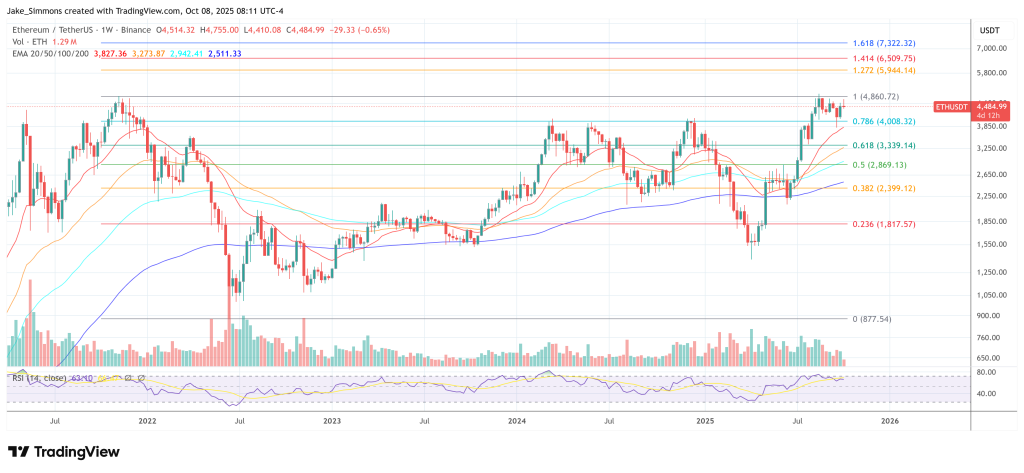
Joseph Lubin, Ethereum co-founder and head of ConsenSys, appeared on Bloomberg Crypto on October 7 and confirmed that ConsenSys is building a prototype for SWIFT's new blockchain-based shared ledger. Announced by SWIFT at Sibos in Frankfurt last week, the plan will add a permissioned, ever-running ledger to the global messaging cooperative's infrastructure and fundamentally integrate ISO. 20022 Financial Messaging.
SWIFT is built on Ethereum.
Lubin said the first build “will most definitely implement messaging, financial messaging, using ISO 20022.” While SWIFT itself is “cautious to focus on the messaging part,” some participating banks are “interested in potentially diving into the payments layer,” he added.
“You have to be careful about what I say. This is a project that we're building. There will be technologists on their side and a lot of technologists on our side. And I'm glad you call it a prototype, because that's what it is,” the ConsenSys founder added.
He declined to give a timeline for distribution. “I have an idea of what kind of timeline it is and I can't say too much about it. We're defining what we believe the final state will be and we're pulling back on that, so I don't know if SWIFT will be comfortable with releasing the timeline at this point,” Lubin said.
SWIFT's move, explicitly structured as a shared ledger that records, orders and verifies transactions, was revealed on September 29, with the cooperative saying the project will provide instantaneous 24/7 cross-border transactions on a global scale while remaining asset-agnostic and interoperable with public and private networks, and “create a path to digital finance.” He emphasized that the goal is to accelerate the “transition.” The official material did not specify the name of the base chain, but did list ConsenSys as a key technology partner and highlighted ISO 20022 compliance and smart contract enforcement business rules.
In the Bloomberg interview, Lubin emphasized broader strategic changes. In other words, the long-standing separation between “TradFi” and “DeFi” is breaking down. “Ever since Ethereum launched, we have had to stay in our own orbit. The mood in Frankfurt was very different,” he said, explaining the overwhelmingly positive bank feedback and saying “it is time for TradFi to merge or leverage DeFi.” He also characterized the current build as a true prototype with technology experts “on their side and many on our side” and reiterated that SWIFT will control the messaging scope and the bank will explore deeper layers such as atomic settlements.
What “Using Ethereum” Really Means
SWIFT did not officially specify the base chain in its press release, but several industry reports following Sibos and subsequent public comments from Lubin indicate that the prototype will run on Ethereum infrastructure, specifically ConsenSys' Linea, an Ethereum Layer 2 network using zero-knowledge proofs to meet banking compliance requirements. They said they would deploy their builds within the Ethereum ecosystem while maintaining permissioned boundaries. These reports are consistent with ConsenSys' own statement that it “supports Swift with early-stage prototypes” for shared ledgers.
Institutional context matters. SWIFT's ledger initiative comes amid the rapid growth of the $300 billion stablecoin market and a wave of bank tokenization pilots. The stated design goal is not to replace existing rails, but to extend them, allowing banks to choose tokenized processes that improve speed, transparency, and finality.
Beyond SWIFT: Rubin's Treasury Paper
Lubin also used the Bloomberg segment to discuss the rise of “digital asset-backed bonds” (DATs), such as the Ethereum-focused vehicle he chairs at SharpLink. He argued that corporate ETH accumulation is a “volatility mitigating factor,” described ETH as “a productive, yielding asset, unlike Bitcoin,” when staking, and outlined a Berkshire-style flywheel where the growing ETH base would be distributed across Ethereum-based protocols for non-dilutive growth.
The strategic path is clear. As financial institutions standardize on Ethereum-based rails for messaging and payments, balance sheet ETH will become a strategic asset for institutions seeking exposure to network activity and yield.
At press time, ETH was trading at $4,484.

Featured image created with DALL.E, chart from TradingView.com

editing process for focuses on providing thoroughly researched, accurate, and unbiased content. We adhere to strict sourcing standards, and each page is diligently reviewed by our team of top technology experts and seasoned editors. This process ensures the integrity, relevance, and value of the content for readers.

